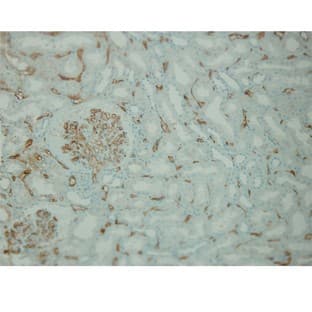
Supplier:
Innovative Research, IncCat no: IRAAKT2535-1 Kit (96 Wells)
Human Retinol Binding Protein (RBP) Serum EIA Kit
Retinol binding protein (RBP) is from a family of structurally related proteins that bind small hydrophobic molecules such as bile pigments, steroids, odorants, etc. RBP is a highly conserved 21 kDa single-chain glycoprotein, consisting of 182 amino acids with 3 disulfide bonds, that has a hydrophobic pocket which binds retinol (vitamin A). RBP binds retinol in a 1:1 stoichiometry, which serves to not only solubilize retinol but also protect it from oxidation. When in serum, the majority of RBP bound with retinol is reversibly complexed with transthyretin. This complex transports retinol to specific receptors of various tissues in the body. Vitamin A status is reflected by serum concentration as it is homeostatically controlled and does not fall until stores are dramatically reduced. RBP has been shown to be a useful surrogate marker for retinol because of the correlation between retinol and RBP in serum, which implies that RBP may be used to monitor vitamin A deficiency (VAD). The WHO has estimated that 250 million children have moderate to severe VAD due to lack of adequate nutrition, and the rising cost of food staples around the world further exacerbates this problem. In addition to nutritional deficiencies, infectious stresses have been shown to depress retinol concentrations and individuals with diseases such as cystic fibrosis and HIV-1 also run the risk of VAD due to the infectious stresses that contribute to the disease. Modulating RBP4 levels may lead to new strategies in treating type 2 diabetes.
Prices direct from Innovative Research, Inc
Quick response times
Exclusive Absave savings/discounts
SPECIFICATIONS
Catalog Number
IRAAKT2535-1 Kit (96 Wells)
Size
EA
Certificate Of Analysis
http://www.innov-research.com/human-hormone-kits/4574-human-retinol-binding-protein-rbp-serum-eia-kit.html
SUPPLIER INFO
Hosts
Hum
Reactivities
Sheep
Latest promotions
Buy any polyclonal or monoclonal antibody from our extensive range of pre-made antibodies and for a limited time only receive a $50 discount!(T&C apply:...
New brilliant antibodies, and new lower prices!For flow cytometry reagents in general, \"bright is better.\" The violet-excitable BD Horizon™ BV421 and...
10% Discount on 2 Rabbit Polyclonal Antibody Service. With over 20 years experience, SDIX has developed into the premier US custom antibody producer,...
For the past decade scientists have extensively used ATS secondary toxin conjugates to make their own targeted toxins for in vitro use.The ability to combine...
We're so sure that you'll prefer Cayman Assay kits over your present brand that we're willing to give you a free assay kit to prove it!
Did your supplier increase the price of Fetal Bovine Serum? Did they substitute the US Origin with USDA? Well say no more! Innovative Research is still...
Bulk Cytokines with Custom Vialing.20 - 50% off cytokines, growth factors, chemokines and more...For a limited time Cell Sciences is offering substantial...
Are you planning to have a customised antibody made for your research?Since 2000, Everest has been producing a catalog containing thousands of affinity...
Top suppliers
Agrisera AB
11 products
Biotrend
Biosensis
969 products
ABBIOTEC
3011 products
SDIX
1 products
Spring Bioscience
2291 products
Cell Signaling Technology
4976 products
Rockland Immunochemicals, Inc.
7592 products
Boster Immunoleader
1533 products
OriGene Technologies Inc.
5281 products
Maine Biotechnology Services
227 products
BD (Becton, Dickinson and Company)
1 products
ABNOVA CORPORATION
Randox Life Sciences
1502 products















